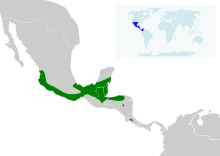Van Gelder's bat
Van Gelder's bat (Bauerus dubiaquercus) is a species of vesper bat in the family Vespertilionidae. It is found in Belize, Costa Rica, Honduras, and Mexico. The species is monotypic within its genus.[2] It is part of the tribe Antrozoini within the subfamily Vespertilioninae and is related to the pallid bat (Antrozous pallidus).[3][4] The bat is found in forest habitat from sea level to elevations as high as 2300 m, although not usually above 1300 m, and is insectivorous and crepuscular.[1] It apparently has a fragmented distribution, and is threatened by deforestation.[1]
| Van Gelder's bat | |
|---|---|
| Scientific classification | |
| Kingdom: | Animalia |
| Phylum: | Chordata |
| Class: | Mammalia |
| Order: | Chiroptera |
| Family: | Vespertilionidae |
| Genus: | Bauerus Van Gelder, 1959 |
| Species: | B. dubiaquercus |
| Binomial name | |
| Bauerus dubiaquercus Van Gelder, 1959 | |
 | |
Taxonomy and etymology
The bat was discovered by Richard Van Gelder, then curator of mammalogy at the American Museum of Natural History. The bat was collected on the AMNH Puritan Expedition to Baja California in 1957 on the Tres Maria Islands (south of Baja) by Richard Zweifel (expedition herpetologist) and Oakes Plimpton (expedition assistant).[5] Van Gelder dubbed the bat "dubiaquercus" in honor of the collectors: dubia means "doubt" in Latin, as zweifel does in German; quercus is Latin for "oak".[5]
Range and habitat
Van Gelder's bat is found in Central America where its range includes Belize, Costa Rica, El Salvador, Guatemala, Honduras, Mexico, and Nicaragua. It has been documented at a range of elevations from 100–2,300 m (330–7,550 ft) above sea level.[1]
Conservation
As of 2018, it is evaluated as a near-threatened species by the IUCN. It meets the criteria for this classification because it is locally uncommon throughout its range; it is experiencing significant population declines; and its habitats are "highly fragile".[1]
References
- Solari, S. (2018). "Bauerus dubiaquercus". IUCN Red List of Threatened Species. 2018: e.T1789A22129523. Retrieved 2 April 2020.
- Simmons, N.B. (2005). "Order Chiroptera". In Wilson, D.E.; Reeder, D.M (eds.). Mammal Species of the World: A Taxonomic and Geographic Reference (3rd ed.). Johns Hopkins University Press. p. 499. ISBN 978-0-8018-8221-0. OCLC 62265494.
- Roehrs, Z.P.; Lack, J.B.; Van Den Bussche, R.A. (2010). "Tribal phylogenetic relationships within Vespertilioninae (Chiroptera: Vespertilionidae) based on mitochondrial and nuclear sequence data". Journal of Mammalogy. 91 (5): 1073–1092. doi:10.1644/09-MAMM-A-325.1.
- Naish, D. (2011-04-11). "Antrozoins: pallid bats, Van Gelders bat, Rhogeessa Baeodon!! (vesper bats part XI)". Tetrapod Zoology. ScienceBlogs LLC. Archived from the original on 2013-04-13. Retrieved 2017-06-11.
- Plimpton, O. A. (22 July 2013). 1957 Expeditions Journal: Baja California American Museum of Natural History Expedition Journal Spring 1957 Huautla Mexico Seeking The Sacred Mushroom With Gordon Wasson Summer 1957. iUniverse. ISBN 978-1-4759-8973-1. OCLC 857924221.
